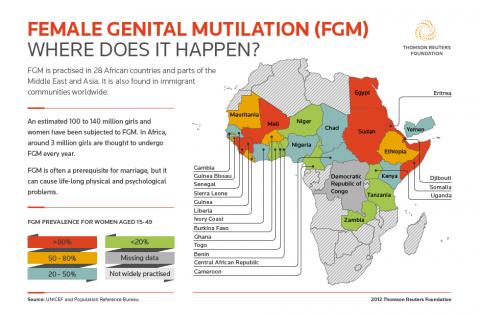
Female genital mutilation (FGM) is a customary practice affecting the health of children. Practiced in many parts of the world, FGM violates the dignity as well as the right for many girls to govern her own body.
Definition
Also called female circumcision, FGM consists of the removal of part, or all of the external genitalia of a girl or woman, or of their mutilation in any other way, for cultural or other non-therapeutic reasons.
Such practices are a violation of the Rights of the Child as they are usually performed on girls aged 0-15 years.
The causes
Such mutilations are practiced for a number of reasons that can be religious, cultural or sanitary. Yet these inhumane and degrading practices are actually a barbaric way to preserve young girls virginity.
They are often considered as a rite of passage into adulthood. Parents, especially mothers who have yet experienced the same suffering and humiliation, feel compelled to subject their daughters to this ritual in order to ensure their social integration, and that of their entire family.
Refusing to undergo such rituals may be ground for social exclusion of the girl, or even her entire family. In extreme cases, the girl might even be killed.
The consequences
The conditions in which these methods are practiced: precariousness, lack of hygiene, absence of medical staff and lack of anesthesia, have a devastating impact on the girls’ physical and psychological health. Each year, thousands of girls die from health complications caused by mutilation, which expose them to severe pain, infections and risk of internal bleeding.
Moreover, studies have shown that genital mutilation of mothers has a negative impact on their infants who show much higher risks of dying at birth.
Aesthetic Genital Mutilation
Aesthetic genital mutilation is a surgical procedure that is performed on the genitals of a child of either sex, in order to clarify a child’s gender.
It is not well known to the general public, but such surgery is frequently performed on children, most notably, but not exclusively, in developing countries. Though carried out under anaesthesia, these surgeries remain acts of mutilation due to their irreversible nature and the fact that they are carried out without the consent of the child.
Circumcision
Circumcision is the practice of surgically removing the foreskin of a male child.
Often performed for religious purposes, circumcision is recommended by the World Health Organization for its benefits to health in reducing by 60% the rate of transmission of sexually transmitted disease between men and women during sexual intercourse.
Despite its benefits, circumcision remains controversial for the reason that it is an irreversible physical mutilation performed on children without the consent of those children and, as such, has the potential to detrimentally interfere with their emotional development and wellbeing.
Currently, more than 130 million girls and women have undergone female genital mutilation worldwide, and each year, three million girls are at risk of suffering the same fate.
Female genital mutilation is mainly practiced in Africa (in 28 African countries), with over 90 million circumcised girls and women, which means 1 in 3 women has to live with the consequences of sexual mutilation.
FGM is also practiced in Malaysia, Yemen and Indonesia, as well as in some ethnic groups in Central and South America. It even exists in developed countries, due to immigrant families who perpetuate their traditions.
Female genital mutilation: a destructive customary practice
Customary practices are defined as practices inherited from the past that are accepted and respected by all members of a community. Out of respect for these customs, communities keep practicing female genital mutilation.
However, these mutilations damage the physical and mental health of young girls who, by this act, have their lives or their development put at risk. Considered as going against human rights, moral values in communities must change so that detrimental traditional practices are completely eradicated.
Aesthetic Genital Mutilation
Aesthetic genital mutilation is a surgical procedure that is performed on the genitals of a child of either sex, in order to clarify a child’s gender.
It is not well known to the general public, but such surgery is frequently performed on children, most notably, but not exclusively, in developing countries. Though carried out under anesthesia, these surgeries remain acts of mutilation due to their irreversible nature and the fact that they are carried out without the consent of the child.
Circumcision
Circumcision is the practice of surgically removing the foreskin of a male child.
Often performed for religious purposes, circumcision is recommended by the World Health Organization for its benefits to health in reducing by 60% the rate of transmission of sexually transmitted disease between men and women during sexual intercourse.
Despite its benefits, circumcision remains controversial for the reason that it is an irreversible physical mutilation performed on children without the consent of those children and, as such, has the potential to detrimentally interfere with their emotional development and wellbeing.
Source: Humanium
 FR
FR EN
EN AR
AR








